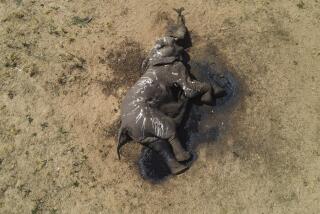Cattle Graze With Rhino in Swazi Project
- Share via
MKHAYA, Swaziland — In a tiny Swaziland game reserve, endangered black rhino browse with cattle in a project aimed at showing how conservation can save Africa from famine.
Swazi conservationist Ted Reilly established the Mkhaya game reserve in 1976 primarily to preserve the indigenous Nguni cattle breed, then in danger of being cross-bred out of existence.
He used profits from sales of the cattle and donations from wildlife conservation groups to expand the 14,880-acre reserve into a sanctuary for endangered species and a wilderness haven for tourists.
“It was important to save the Nguni because the breed is the most efficient at converting vegetation into food under African conditions,” Reilly said. “And that is vital for Africa.”
The Nguni, whose characteristic mottled hide was used for Zulu war shields, has acquired a natural resistance to heat, drought and tick-borne disease through hundreds of years of natural selection.
Reilly is aware that some visitors to Mkhaya might be put out to come across cattle as they search for rhino, elephant or exotic birds on the reserve’s Acacia savannah.
“For that reason we keep some areas of the park free from cattle,” he said. “But you must remember that Nguni have been grazing alongside wild antelope for about 1,200 years.”
Hunting and habitat destruction had long driven the last black rhino from Swaziland before Reilly reintroduced the species, bringing six from Zimbabwe to form the nucleus of what he hopes will eventually be a herd of about 40.
One of the major expenses of the reserve is electrified fencing to keep the animals in and poachers out.
Conservationists estimate that rhino horn poachers slashed Africa’s black rhino population from 15,000 in 1980 to 3,700 in 1987, and the slaughter continues.
The presence of rare animals at Mkhaya, including several species of antelope, helps attract tourists and their valuable foreign exchange to the small African kingdom.
The combination of various species ensures optimum use of vegetation because each favors different plants. While the cattle and white rhino graze the grass cover, giraffe, kudu and elephant browse on thorn trees.
Surplus game also provide venison. Visitors to Mkhaya feast on impala chops and wildebeest sausage cooked over an open fire under the giant leadwood trees of a tented camp on the bank of a dry riverbed.
They awake at dawn to take advantage of the cool morning hours, which are best for game viewing.
Guides lead visitors on foot to within 20 yards of a family of white rhino, more docile than their black cousins, as they wallow in a mud hole.
More to Read
Sign up for Essential California
The most important California stories and recommendations in your inbox every morning.
You may occasionally receive promotional content from the Los Angeles Times.










